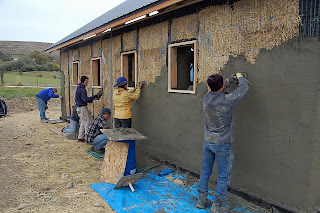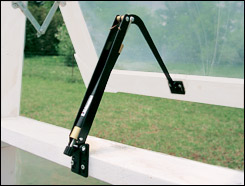There were 65 struts to cut for a 2V geodome, 35 'A' pieces and 30 'B' pieces - the B struts are longer than the A's. Given my 16 foot diameter (8 foot height), the A pieces were just over 4 foot long and the B pieces just under 5 foot. This worked out well for using 10 foot long 2x4's without much wasted wood. I bought 35 of these, allowing a little bit extra for mistakes. As a novice carpenter I'm proud to say I only screwed one strut up, so anyone can do this with a bit of patience. Once the pieces were cut to length, the tricky part is cutting the arrowed angle cuts at each end. For this I borrowed a friend's Bosch dual angle miter saw. You need a saw that will do a 60 degree cut, preferably on both sides of the saw, but you can make it work if just one side will do this cut. Cutting the struts took me about 10 hours in total, I took my time over it because it's worth getting the cuts accurate. It worked for me doing it in two sessions, one for the A's another for the B's.
Once I had them cut I laid out the struts and stained them with a couple of coats of a good quality wood stain. This will protect the wood from the humidity and UV in the growing space and will ensure maximum longevity for the structure.
The straw bales I sourced from a local feed supply co-operative. At $5 per bale I ended up paying more than I would have buying direct from a farmer (typically 3-4 bucks per bale), but it was a convenient source not too far out from the city, which when transporting them yourself makes a difference. It took two trips in a rented pickup truck to transport the 30 bales that I bought. The second trip I appreciated having a friend along who had grown up on a farm and knew how to stack bales properly - the first trip was a bit fraught, with the tarp and load threatening to fall off at any point. With the materials assembled it was time to build!
We laid the first layer of bales, then checked them in relation to the base of the dome frame to make sure they were positioned correctly. I wanted the base of the frame to fit around the edge of the bales, but still be well supported by the wall. We realized that this was easiest to achieve by actually screwing the base octagon together -playing with it with the pieces separate just made us confused!
Another point of confusion came from measuring across the structure and it not being 16 feet, but just over 15. It was only later that day that I realized this was because we were measuring from the center of the struts, rather than from the corners. Doh!
Once the bale wall was positioned to our satisfaction, we started to stuff all the cracks between the bales. Aside from aesthetic concerns with holes and cracks, stuffing is important to make sure there are no air pockets in the wall, since these can become points where humidity builds up, can meet with cold air and condense, causing moisture problems. With stuffing complete, we hammered bamboo stakes through the bales to secure them together to provide a bit of structural integrity. Then it was time to build the dome frame - this part seemed to be easier to do with just a couple of us doing it, there wasn't a lot of space inside the dome frame and more people would have made it trickier.
The way to construct the frame is to build the triangles of each layer first, then connect them along the top with the cross struts.
As long as you keep track of whether you need an A or a B piece, the frame construction is fairly straightforward and quite satisfying - you get to see the results of your work quickly. We used 1 3/4 inch screws to secure the struts to each other.
When we started to do the second layer, it was apparent we needed some support for the triangles before they were fully connected together, so we used a couple of the spare 10x2x4's to do that.
After you get a few of these supports on the go, space to work becomes a bit limited, but it did make sense to keep the structural integrity before the dome could hold itself together.
We were amazed when the dome finally came together at the apex. Not every hub had neatly aligned on the way up, so we were joking about how far off we would be.
We reasoned that getting the base and first row of triangles as close to perfect as possible really effects how things go together further up
.
Cost and Effort:
The bale walls and dome frame can easily be built by two people in a day.
Bales: $150
Wood: $150
Stain: $30
Screws: $20
Total: $350
Lessons learned:
Having all the bales and wood struts and a lot of people around in a small yard was pretty chaotic. This was one case where having less people around to complete the basic structure made it easier. I wouldn't want to try to do the frame on my own though as I have seen some people do it, two pairs of hands made sense for this part of the job.
Transporting a lot of bales using a pickup is pretty hairy if you don't know what you're doing. Having a friend that knows how to stack them really helped.
I would take more time selecting the bales myself next time. I didn't have a choice at the vendor I went to, they just threw down bales to us from the barn. Good square bales with tightly packed straw and well cut sides make a huge difference to the plastering process, we had too many loose, unruly bales in our collection and some of them were moldy inside which can make the wall unhealthy and structurally weak.
Acknowledgements:
Thanks to Darren, Malte, Julie, Randi, John, Sunni and Avalon for your help with this part of the construction.












